The Software Development LifeCycle (SDLC)
The System Development Lifecycle (SDLC) is often described as a structured process used by organisations to design, develop, and implement software systems. The idea is that it should serve as a framework to ensure that high-quality systems are delivered in a methodical, organised way. However, the term “System Development Lifecycle” can be considered misleading in several ways due to the assumptions it might create about the process.
The word “lifecycle” suggests that the development process is always sequential, moving in a strict, linear order from one stage to the next. In reality, many SDLC models (e.g., Agile) are iterative or cyclical, with stages revisited multiple times throughout the project. Development often involves feedback loops, where progress may revert to earlier phases for refinement. The linear approach is often associated with rigid, waterfall models of development, where one stage must be completed before the next begins. This can be misleading for teams that use Agile, DevOps, or other methodologies that emphasise flexibility, continuous development, and the delivery of smaller, incremental changes rather than a single “complete” system.
The term “lifecycle” also implies that the process ends when the system is delivered or implemented, but in most cases, systems require ongoing maintenance, updates, and adaptations long after their initial deployment. These post-implementation activities (like system maintenance and upgrades) are often just as critical as the development phases themselves. Likewise, the term “system development” focuses heavily on the development aspect, which might overshadow the importance of other phases like planning, analysis, design, and testing. It can also overlook the significance of post-launch activities like monitoring, maintenance, and decommissioning.
These criticisms do not mean that the SDLC concept is not useful, but it should be approached with a degree of caution. Any model that oversimplifies reality will carry risks with it. In some ways the SDLC is similar to the idea of an abstract class in object-oriented development: it is never instantiated directly and instead acts as a prototype for other classes as depicted inn Fig. 1. The SDLC can be interpreted in a linear way and can also be implemented in an agile, iterative way. In both cases, the development team carries out the same activities but they are organised differently.
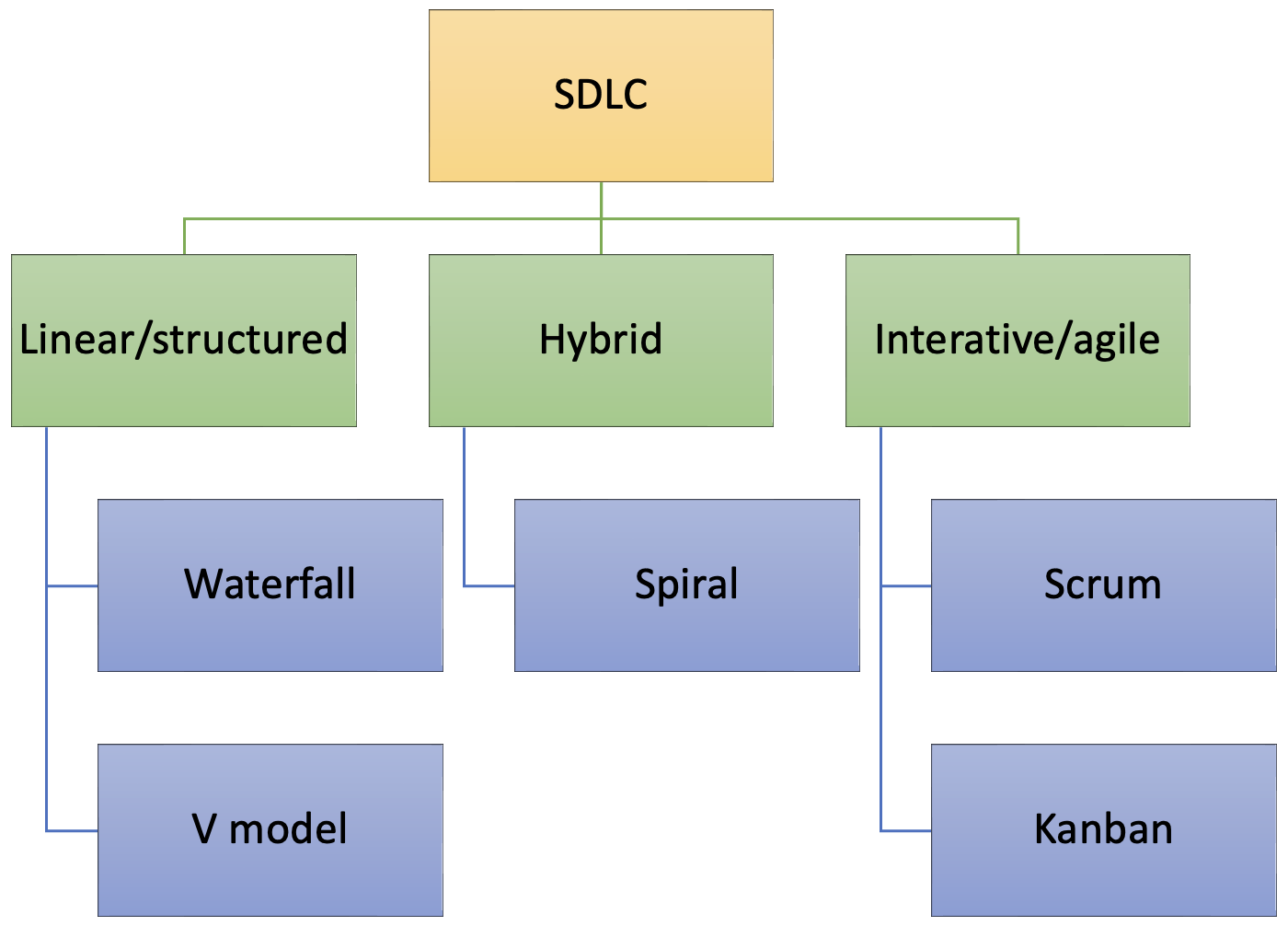
Lifecycle activities
The internet provides many versions of “the” SDLC that break the job of building software into different activities. However, there is no agreement on just how many activities or phases there are, or indeed what they should be called. The international standard ISO24748-1 defines six standard lifecycle phases as shown in the table below.
| Stage | Description |
|---|---|
| Concept | <ul><li>Identify stakeholders’ needs</li><li>Explore concepts</li><li>Propose viable solutions</li></ul> |
| Development | <ul><li>Refine system requirements</li><li>Create solution description</li><li>Build system</li><li>Verify and validate system</li></ul> |
| Production | <ul><li>Produce system</li><li>Inspect and test</li></ul> |
| Utilisation | <ul><li>Operate system to satisfy users’ needs</li></ul> |
| Support | <ul><li>Provide sustained system capability</li></ul> |
| Retirement | <ul><li>Store, archive or dispose of system</li></ul> |
The terminology in the table is rarely used exactly as shown. The main reasons are that the term used in the standard is too broad and needs to be further divided, that the distinction between terms is not useful, or that there is some important aspect that is not covered. Many versions separate requirements analysis and development into different phases, for example. Most also combine Utilisation and Support as Maintenance. More elaborate versions of the SDLC include a distinct phase for documentation. Different models are shown with between five and ten phases with six being the most popular number as exemplified in Fig 2.
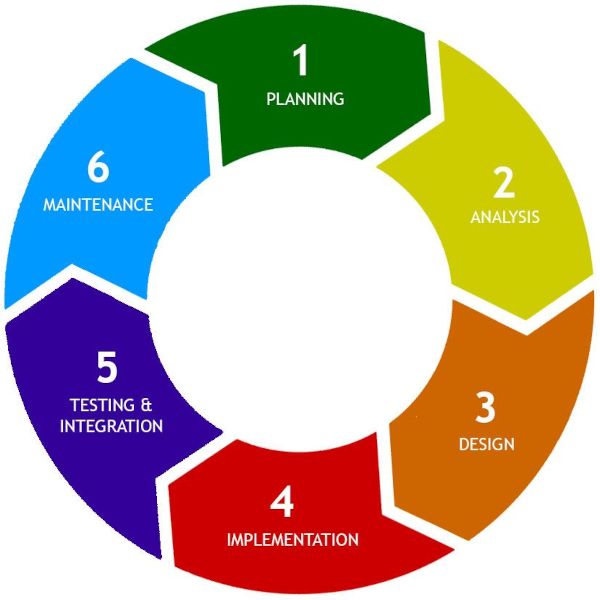
As you can see, the typical model ignore the retirement or disposal stage which can be important in long-term planning.
Structured methods
A structured software development methodology is a disciplined approach that implements the SDLC as a sequential series of project phases. They focus on thorough upfront planning and design to reduce risks and avoid costly changes later in the process. The idea is that this approach fosters stability and predictability, making it ideal for projects where requirements are well understood from the start and unlikely to change significantly during development. Structured approaches are used in industries where predictability, control, and thorough documentation are essential. These industries often have strict regulatory environments, require high levels of risk management, and typically work with stable requirements that do not change frequently. Examples include
- Aerospace and Defense
- Healthcare and Medical Devices
- Government and Public Sector
- Manufacturing
- Energy and Utilities
Agile methods are being adopted to varying degrees in industries traditionally dominated by structured development, but the extent of adoption is often tied to the flexibility of the project type. Agile is most commonly applied to software development, IT, and digital transformation projects, while more rigid, safety-critical, or highly regulated areas tend to stick to structured or hybrid methodologies. In many cases, industries are adopting “hybrid” approaches, where Agile techniques are combined with structured practices to balance flexibility with the need for compliance, predictability, and risk management.
Waterfall model
The waterfall approach, originally introduced by Winston Royce (1970), advocates a strict sequence of project stages as shown in Fig. 3. The waterfall approach is an extreme expression of what Stephens calls a predictive model. The idea is that when the requirements are clearly and comprehensively defined in advance, these models will work well.
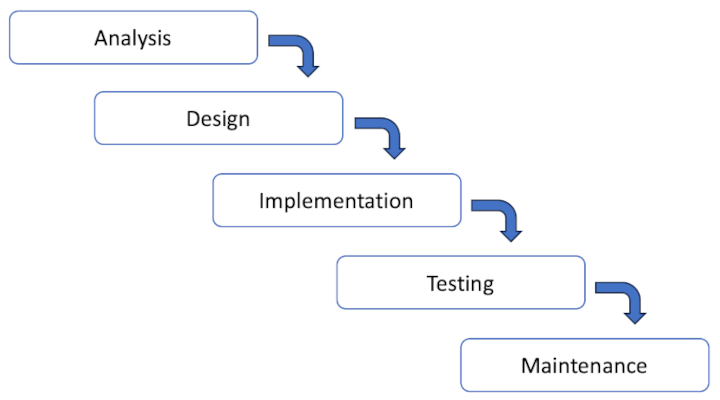
Strictly adhering to the sequential nature of the stages in the waterfall approach leads to a number of practical difficulties. These include
- The inability to introduce requirements later in the project if they were overlooked at the start
- The rigidity of the specification and design - once approved, they cannot easily be changed if problems emerge
- The postponing of any major testing until all the code is complete
To address these issues, several modifications to the waterfall approach have been proposed including the two outlined below.
The V model
The main innovation in the V model was to identify different types of testing that were used at different stages of the project. This went some way to resolving the problem with postponed testing, but other issues still remained.
)](images/v-model.png)
The waterfall model with feedback
Another refinement of the waterfall model attempted to reconcile the sequential nature of the stages with the reality of discovering error over time by introducing feedback loops. The idea was to contain errors within a phase so that the transition to the next phase could still be made cleanly. In fact, this version of the waterfall model incorporates ideas from Royce’s original paper. The main idea is that events during the project can trigger the return to an earlier stage as illustrated in Fig. 5.
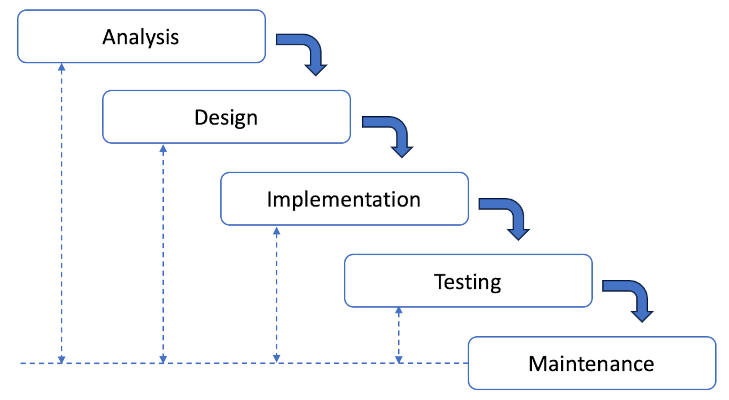
The iterative waterfall model
The number of variations on the waterfall model are evidence that something was wrong and needed fixing. A further version proposed the idea of a single project being decomposed into a series of waterfalls, one feeding into the next as shown in Fig. 6.
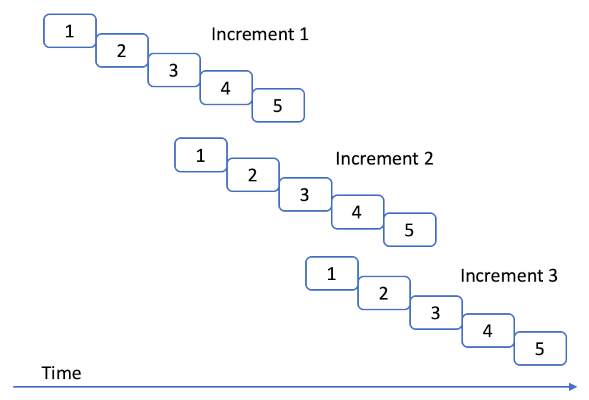
The spiral model
In another step away from the strictly linear approach, Barry Boehm introduced the spiral model in 1986. While visually complex, the spiral model, shown in Fig. 7, was based on the idea that risk management should be the main concern in software development projects. Starting with simple, fundamental piece of the development, it explicitly captured the concept of iterative prototyping by following a repeating pattern of four stages:
- Determine objectives, alternatives and constraints
- Evaluate alternatives and identify and resolve risks
- Develop and verify next-level product
- Plan next phase images However, it also inherited extensive testing towards the end of the project from the traditional waterfall approach.
)](images/spiral.png)
Summary
Structured development methods, such as the Waterfall, V-Model, and Spiral Model, offer robust, methodical frameworks for developing complex systems, particularly in environments where precision, documentation, and risk management are critical. Each model has its strengths: the Waterfall model’s linear approach ensures clear phases and deliverables, the V-Model emphasises continuous verification and validation, and the Spiral Model incorporates iterative cycles with a focus on risk assessment. While the software industry has increasingly embraced Agile methodologies for flexibility and speed, structured development methods remain essential in industries like aerospace, healthcare, banking, and manufacturing. These sectors continue to rely on structured approaches for projects where stability, regulatory compliance, and risk management are paramount.
The ongoing use of structured methodologies in these industries highlights their enduring value, particularly for projects that demand high levels of control and predictability. Understanding these traditional models provides a foundation for selecting the right methodology based on the project’s requirements, balancing the need for flexibility with the importance of disciplined execution.